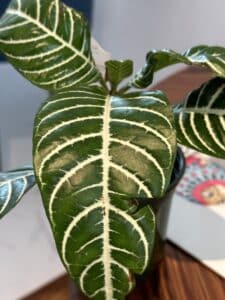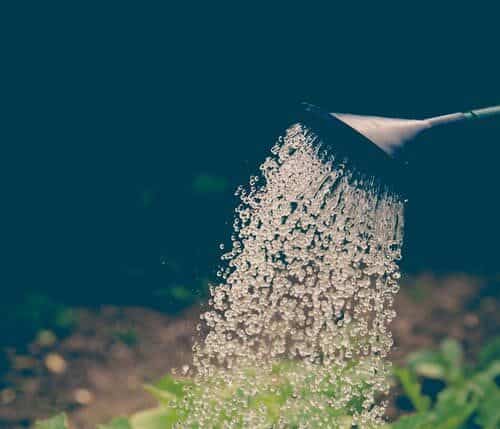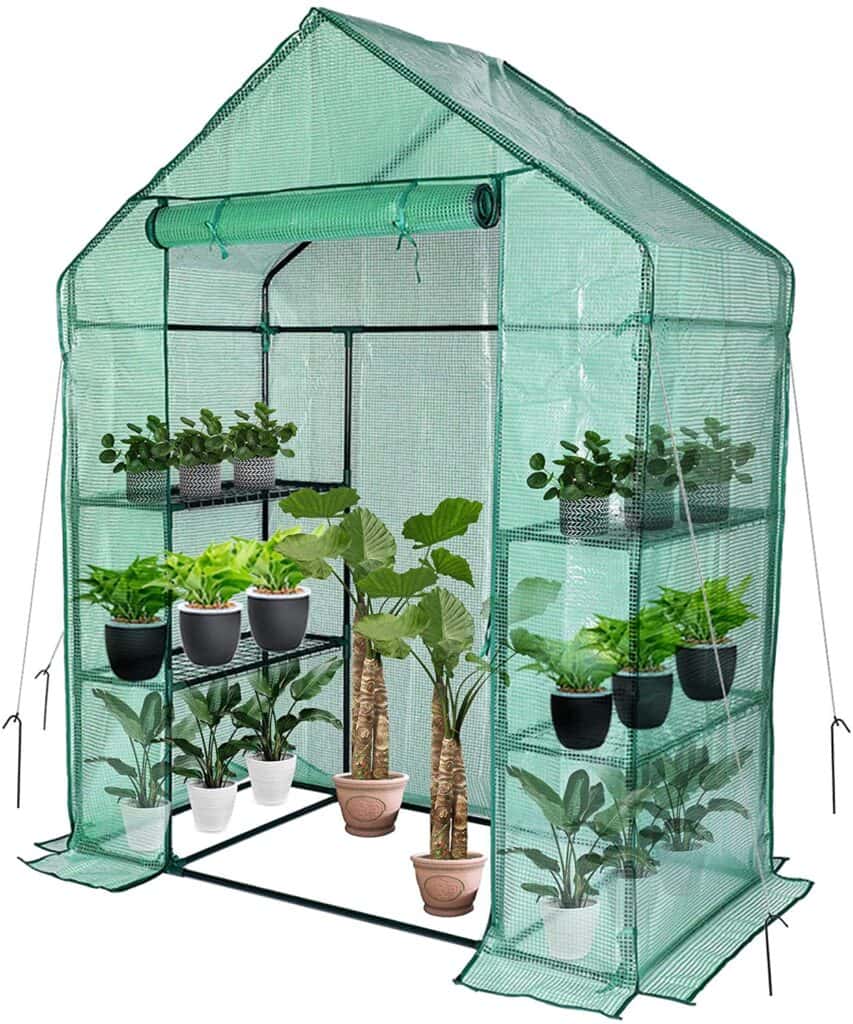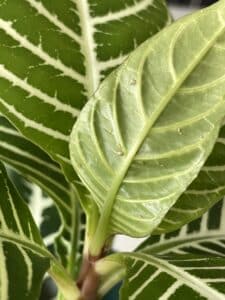I have always cherished my exotic-looking Zebra plant with its beautiful leaves.
It has always been a subject of conversation between my fellow plant enthusiast friends and me.
However, a few days before, I noticed that my Zebra plant leaves started falling off.
After some research and talking to some experts, I found out why that was happening and how to solve it.
The most common reason for the falling off of Zebra plant leaves is watering issues. However, too much fertilizer or too extreme a temperature can also cause your leaves to fall off. Other major causes for Zebra leaves falling off are inadequate light, pests, and flower bract fading, which we will discuss below.
Native to North, Central, and South America, the Zebra plant is primarily grown for its striking lush green leaves.
Calatheas and Aphelandras are the main species of Zebra plants whose leaves start falling off if not provided with proper care.

If the Zebra plant leaves start falling off and becoming naked, there is no point in growing one.
Read the article till the end to prevent your Zebra plant leaves from falling off and how to solve this problem.
Table of Contents
Is it Normal for Zebra Plant to Lose Leaves?
The short answer to this question is NO. But, there are exceptions to that.
Zebra plants can lose their leaves while placed in a new location. It does lose leaves to adjust to the new environment and temperature.
If this is the case, then there is nothing much to do. The plant will take care of itself.
If the leaves of your Zebra plants start turning brown before falling off, then we can attribute this fact to old age or prevent water loss.
But if your Zebra plant’s leaves are falling off even when it’s healthy green, then it is a sign that something is seriously wrong and needs fixing immediately.
Causes of Leaves Falling Off in Zebra Plant
Seeing your plant leaves falling off is a disheartening situation for anyone. More so, if you don’t how to prevent it.
Below are some of the common reasons why your Zebra plant leaves are falling off.
1. Overwatering and Underwatering
Keeping soil moisture levels stable in indoor plants can be difficult. Falling off of your Zebra plant leaves can occur due to either too wet or too dry soil.
When a plant receives excessive water, it starts to flood because there is nowhere else to go.
It results in yellowing of the leaves, which then turns mushy. It causes extra weight on the leaves, causing their structure to deteriorate and the leaves to fall off.
Similarly, when under-watered, you will notice that the leaves of the plant start wilting and drooping. After this happens, it won’t take long for the Zebra plant leaves to start falling off.
A good way to check if the soil is properly moist or not is to push your finger an inch deep in the soil. If the soil is too soggy, then it means that you have overwatered your plant. If the soil feels dusty and arid, then it is a sign of underwatering.

Tip: Always use Lukewarm water for optimal growth.
Solutions
- Zebra plants should be deep watered when the soil dries off completely. It usually means watering your Zebra plant once every two weeks if you use a pot to grow it indoors.
- Keep the soil consistently moist in the summer season, which allows enough water for the plant to soak. Let the soil dry off a bit between watering when winter comes.
- In early winter, the growth of the plant will be minimal. It won’t need more water than usual. Try not to water frequently during those times, and don’t allow the soil to dry off completely.
- By the late winter months, you will see new growth on the plant. It is best to water it with a weak fertilizer solution once every two weeks.
2. Overfertilizing
Fertilizer has been a boon for every plant grower since its invention. But sometimes, a boon can also be a curse if overextended.
If you start fertilizing your plant too much, it will cause a lot of damage to your plant.
Yellowing of leaves, brown leaf tips, stunted growth, and falling off of leaves are all symptoms of overfertilizing.
Besides hindering your plant’s growth, too much fertilizer also leaves your plant vulnerable to diseases and pests.
Another sign of overfertilizing is the excess salt buildup- on the surface of the plant. If you start seeing white buildup on the topsoil, then you need to remove it asap.
The best type of fertilizer to use for your Zebra plant is an all-purpose quick-release water-soluble fertilizer like Miracle-Gro Plant Food.
Some prefer to use organic solutions like blood meal, compost, bone meal, etc. as an alternative to chemical fertilizers.
While it may help to some extent, it might not provide the adequate amount of nutrients to your plants as needed. It would be best for you to not take any risk in this matter.

Solutions
- During the growing season, fertilizing once every 2-3 weeks is a must to ensure that the flowers bloom consistently. But, more than this, then it becomes detrimental.
- During winter, it won’t be necessary to fertilize the plant regularly. Instead, you can rather water the plant with a weak fertilizer solution.
How to Remove Excess Fertilizer?
If you have already done the deed, and your plant starts showing signs of excess fertilizer, then follow the steps to remedy it:
- Take out the pot where you have planted your Zebra plant outdoors.
- Flush the excess fertilizer from the soil by watering your plant.
- Let the water sit for some time and allow it to drain completely.
- Repeat the process one or two times more.
- Also, make sure that you remove any damaged or dying leaves to prevent unnecessary leaching of nutrients.
3. Temperature Extremities
The more extreme the temperature gets, the more leaves your plants will start shedding off.
Both high temperature and low temperature have a damaging effect on the foliage of your Zebra plant.
Too High Temperature
If the temperature is too hot, you will start noticing the leaves falling off one by one.
It is just a normal way to adjust to the temperature. Plants do this to prevent the loss of water through transpiration from the leaves.
Solution
Although it is not something to worry about, you can still prevent this from happening.
- If the temperature is too hot, you can throw a cover or a shade over your plant to lessen the heat.
- Moving to a cooler place is also a good idea.
- If the sunlight is too bright, then you can use a curtain sheer as a shade for your plant.
- Watering deeply can help to prevent moisture loss and drought stress.
- Fertilizing should be strictly avoided during high temperatures.
- Pruning can stress the plant so it should be done when the temperature lowers.
- Repotting should be avoided as it can cause loss of leaves.
Too Cold Temperature
In case the temperature gets too cold, the cells inside the leaves freeze, causing irreparable damage.
The leaves start looking blackish or brownish if the temperature is too cold. There is pretty much nothing to be done in this case.
Solution
- A thick layer of mulch in the soil can act as insulation against the blistering cold.
- Watering the soil before nighttime can help to raise the overnight temperature.
- A light breezy air during the night can prevent your plant from frosting.
- You can put an incandescent bulb 2-3 feet above your plant to increase its temperature.
- Covering the plant with a garden blanket or old bedsheets can also help in maintaining temperature.
Prevention
- You should strictly avoid overexposing your plant to sunlight. Try to keep it at a shady place as much as possible.
- The ideal day room temperature is about 70°F.
- 55-60°F is the optimum temperature for your Zebra plant at night-time.
4. Not Enough Light
Light is an essential factor in making food for your plants.
If you can’t provide enough light to your Zebra plant, it won’t have the necessary resources to make food and stay alive.
In response to that, your plant starts shedding off leaves to prevent energy loss.
Moreover, succulents like the Zebra plant love plenty of light for growth.
You need to place your Zebra plant where it gets indirect but bright sunlight for full growth.
Without enough light, the new leaves will be smaller in size. Eventually, your plant leaves will start falling off.
Solutions
- If your plant is indoors, you can move it to a location where it finds enough sunlight.
- The ideal location to put the plant is a window facing North. Northern windows have enough light to keep the plant blooming without harming the leaves.
- Another good option is to grow the plant inside a greenhouse or a terrarium to maintain the sufficient environmental conditions necessary for the flowers to bloom.
- If you plan to move your plant outdoors, be sure to acclimatize it first.

How to Acclimatize your Zebra Plant Outdoors?
You can acclimatize your Zebra plant by exposing it to about 2-3 hours of sunlight daily.
Gradually increase the amount of time you keep it outdoors for a few weeks.
Repeat this process until it gets 6-7 hours of bright sunlight outdoors each day.
5. Low Humidity
Humidity is an important factor for a succulent like Zebra plant.
A minimum of 70-80% humidity is necessary to keep your Zebra plant thriving. It is a pretty high number considering that the average humidity of your room is around 30%.
If the environment that you are growing your Zebra plant is dry, then the leaves will start falling off.
It is a natural response to low humidity as your plant is trying to conserve water loss.
Solutions
- You can use an Electric Humidifier to maintain proper moisture levels in the plant environment.
- Misting the plant leaves can also help your plant to retain its moisture level.
- An inexpensive way to maintain high humidity is to use a Humidity Tray or a pebble tray.
- Make sure that your plant is away from the direct line of heat and wind sources.
6. Flower Bract Fading
Bract is the leaf-like structure of the plant from where the flower evolves.
The blooming Zebra plant produces a beautiful exotic plume of yellow bracts. The delicate, beautiful flowers emerge out from these same bracts.
Although the flower lasts for a few days, the bract can stay for around two weeks.
When a flower bract starts to fade, this can also cause a few leaves to fall.
Solution
Although the falling of leaves after the flower bract of the Zebra plant fades is quite normal, you can effectively prevent it by cutting off the bract as soon as possible when it starts to fade.
7. Infestation of Pests and Insects
Pests are natural enemies for any plant.
Incidence of pests like mealybugs, scales, and spider mites are the typically occurring ones. These pests occur as a result of bringing infested plant material to your household.

Especially for plants like the Zebra plant, pests can cause stunted growth, leaf curling, loss of leaves, and death of plants in severe cases.
Check out the table below for the most common pests, their symptoms, and how to get rid of them.
| Pests | Symptoms | Prevention | Solutions |
|---|---|---|---|
| Mealybug | |||
| Spider Mites | |||
| Scale |
8. Diseases
Falling off of leaves can also be caused by diseases to some extent.
However, it is not as common and can be easily prevented if you maintain a proper environment for your plant to grow.
Diseases in the Zebra plant mostly occur due to overwatering and too humid conditions.
All the diseases that can affect the Zebra plant can be grouped under Fungal leaf spot disease.
Solutions
- Avoid over-watering the plant.
- Spraying a mild solution of baking soda ( half teaspoon for 4l water) should be enough to treat this disease.
- Prune infected leaves and dispose of them carefully.
- Improve air circulation and increase light penetration.
- Avoid collection of water in the leaves and water close to the ground.
- Proper spacing of plants can also help to prevent diseases.
How to Prevent Leaves Falling Off in Zebra Plant?
You won’t need any expensive tools or high-level knowledge to take care of your plant properly.
A bit of your attention and your time will go a long way for your Zebra plant.
Small things like watering in time, timely checking for pests, avoiding direct light, etc., goes a long way for your plant.
If you care for your plant properly, you can prevent many problems like leaf curling, wilting, yellowing, and falling off of leaves.
- Soak Watering: Soak watering or bottom watering is a good way to ensure that you don’t underwater or overwater your plant. Place your plant pot in a container filled with water and let them absorb the water for few hours.
- Regular Misting: Regular misting of your plant can help to maintain good humidity levels for your plant. However, make sure that you don’t allow water to collect in the leaves.
- Regular Inspection: The best way to prevent pests is regular inspection. The more attention you give to your plant’s welfare, the fewer problems are likely to occur.
- Acclimatizing your plant: If you plan to move your Zebra plant to a new location, always make sure to acclimate it. A drastic change in the environment is a sure-shot way of getting leaves to drop.
- Proper Temperature: As said above, extremities of temperature can be a big factor for falling off of leaves. Make sure that you keep your plant away from places with draft and high temperatures. Always keep your plant far from fireplaces, air conditioners, or vents.
Let’s take a short look at the Caring Zebra Plant brief summary.
| Parameters | Favorable Condition |
|---|---|
| Temperature | Ideal temperature is 68-75°F and no lower than 55°F. |
| Sunlight | Bright Indirect Sunlight |
| Watering Frequency | Luke warm water once every two weeks |
| Soil Type | Multi-purpose Potting Mix |
| Fertilizer | Balanced fertilizer once every 2-3 weeks in growing season. |
| Humidity | Around 70-80%. Use humidifier, pebble tray or humidity tray |
| Repotting | Repot in 1 size larger pot in spring each year. |
| Pruning and Deadheading | Remove dead leaves and flowers to avoid plant getting leggy |
| Propagating | Propagate by taking a couple of inches long stem cutting. |
Conclusion
By now, you must have realized that the Zebra plant requires more attention and love than other plants.
It is not something that you can leave in the corner and expect to grow beautifully.
However, once you start getting used to the routine care you must perform, it will be a calm meditative experience rather than a tedious task.
There is nothing better than seeing your plant recovering and turning green. It will all be possible through your love and hard work.
To find out if your Zebra plant is harmful to pets, read this article, Is Zebra Plant Toxic to Pets?


